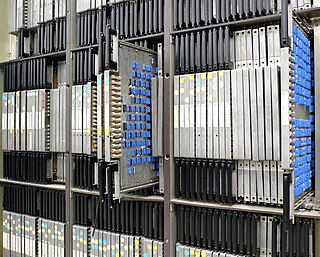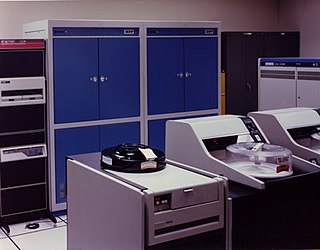
A supercomputer is a computer with a high level of performance as compared to a general-purpose computer. The performance of a supercomputer is commonly measured in floating-point operations per second (FLOPS) instead of million instructions per second (MIPS). Since 2017, there are supercomputers which can perform over 1017 FLOPS (a hundred quadrillion FLOPS, 100 petaFLOPS or 100 PFLOPS). Since November 2017, all of the world's fastest 500 supercomputers run Linux-based operating systems. Additional research is being conducted in the United States, the European Union, Taiwan, Japan, and China to build faster, more powerful and technologically superior exascale supercomputers.

The Cray-1 was a supercomputer designed, manufactured and marketed by Cray Research. Announced in 1975, the first Cray-1 system was installed at Los Alamos National Laboratory in 1976. Eventually, over 100 Cray-1s were sold, making it one of the most successful supercomputers in history. It is perhaps best known for its unique shape, a relatively small C-shaped cabinet with a ring of benches around the outside covering the power supplies and the cooling system.

A Connection Machine (CM) is a member of a series of massively parallel supercomputers that grew out of doctoral research on alternatives to the traditional von Neumann architecture of computers by Danny Hillis at Massachusetts Institute of Technology (MIT) in the early 1980s. Starting with CM-1, the machines were intended originally for applications in artificial intelligence (AI) and symbolic processing, but later versions found greater success in the field of computational science.
Thinking Machines Corporation was a supercomputer manufacturer and artificial intelligence (AI) company, founded in Waltham, Massachusetts, in 1983 by Sheryl Handler and W. Daniel "Danny" Hillis to turn Hillis's doctoral work at the Massachusetts Institute of Technology (MIT) on massively parallel computing architectures into a commercial product named the Connection Machine. The company moved in 1984 from Waltham to Kendall Square in Cambridge, Massachusetts, close to the MIT AI Lab. Thinking Machines made some of the most powerful supercomputers of the time, and by 1993 the four fastest computers in the world were Connection Machines. The firm filed for bankruptcy in 1994; its hardware and parallel computing software divisions were acquired in time by Sun Microsystems.

The Earth Simulator (ES), developed by the Japanese government's initiative "Earth Simulator Project", was a highly parallel vector supercomputer system for running global climate models to evaluate the effects of global warming and problems in solid earth geophysics. The system was developed for Japan Aerospace Exploration Agency, Japan Atomic Energy Research Institute, and Japan Marine Science and Technology Center (JAMSTEC) in 1997. Construction started in October 1999, and the site officially opened on 11 March 2002. The project cost 60 billion yen.

Blue Gene is an IBM project aimed at designing supercomputers that can reach operating speeds in the petaFLOPS (PFLOPS) range, with low power consumption.

The ILLIAC IV was the first massively parallel computer. The system was originally designed to have 256 64-bit floating point units (FPUs) and four central processing units (CPUs) able to process 1 billion operations per second. Due to budget constraints, only a single "quadrant" with 64 FPUs and a single CPU was built. Since the FPUs all had to process the same instruction – ADD, SUB etc. – in modern terminology the design would be considered to be single instruction, multiple data, or SIMD.

The National Cryptologic Museum (NCM) is an American museum of cryptologic history that is affiliated with the National Security Agency (NSA). The first public museum in the U.S. Intelligence Community, NCM is located in the former Colony Seven Motel, just two blocks from the NSA headquarters at Fort George G. Meade in Maryland. The motel was purchased, creating a buffer zone between the high security main buildings of the NSA and an adjacent highway. The museum opened to the public on December 16, 1993, and now hosts about 50,000 visitors annually from all over the world.

ASCI Red was the first computer built under the Accelerated Strategic Computing Initiative (ASCI), the supercomputing initiative of the United States government created to help the maintenance of the United States nuclear arsenal after the 1992 moratorium on nuclear testing.
ILLIAC was a series of supercomputers built at a variety of locations, some at the University of Illinois at Urbana–Champaign. In all, five computers were built in this series between 1951 and 1974. Some more modern projects also use the name.
The Cray-3/SSS was a pioneering massively parallel supercomputer project that bonded a two-processor Cray-3 to a new SIMD processing unit based entirely in the computer's main memory. It was later considered as an add-on for the Cray T90 series in the form of the T94/SSS, but there is no evidence this was ever built.

The Goodyear Massively Parallel Processor (MPP) was a massively parallel processing supercomputer built by Goodyear Aerospace for the NASA Goddard Space Flight Center. It was designed to deliver enormous computational power at lower cost than other existing supercomputer architectures, by using thousands of simple processing elements, rather than one or a few highly complex CPUs. Development of the MPP began circa 1979; it was delivered in May 1983, and was in general use from 1985 until 1991.

The CDC 6000 series was a family of mainframe computers manufactured by Control Data Corporation in the 1960s. It consisted of the CDC 6200, CDC 6300, CDC 6400, CDC 6500, CDC 6600 and CDC 6700 computers, which were all extremely rapid and efficient for their time. Each was a large, solid-state, general-purpose, digital computer that performed scientific and business data processing as well as multiprogramming, multiprocessing, Remote Job Entry, time-sharing, and data management tasks under the control of the operating system called SCOPE. By 1970 there also was a time-sharing oriented operating system named KRONOS. They were part of the first generation of supercomputers. The 6600 was the flagship of Control Data's 6000 series.
The QCDOC is a supercomputer technology focusing on using relatively cheap low power processing elements to produce a massively parallel machine. The machine is custom-made to solve small but extremely demanding problems in the fields of quantum physics.

A computer cluster is a set of computers that work together so that they can be viewed as a single system. Unlike grid computers, computer clusters have each node set to perform the same task, controlled and scheduled by software.

Jaguar or OLCF-2 was a petascale supercomputer built by Cray at Oak Ridge National Laboratory (ORNL) in Oak Ridge, Tennessee. The massively parallel Jaguar had a peak performance of just over 1,750 teraFLOPS. It had 224,256 x86-based AMD Opteron processor cores, and operated with a version of Linux called the Cray Linux Environment. Jaguar was a Cray XT5 system, a development from the Cray XT4 supercomputer.

The term supercomputing arose in the late 1920s in the United States in response to the IBM tabulators at Columbia University. The CDC 6600, released in 1964, is sometimes considered the first supercomputer. However, some earlier computers were considered supercomputers for their day such as the 1960 UNIVAC LARC, the IBM 7030 Stretch, and the Manchester Atlas, both in 1962—all of which were of comparable power; and the 1954 IBM NORC,
A supercomputer operating system is an operating system intended for supercomputers. Since the end of the 20th century, supercomputer operating systems have undergone major transformations, as fundamental changes have occurred in supercomputer architecture. While early operating systems were custom tailored to each supercomputer to gain speed, the trend has been moving away from in-house operating systems and toward some form of Linux, with it running all the supercomputers on the TOP500 list in November 2017.
SUPRENUM was a German research project to develop a parallel computer from 1985 through 1990. It was a major effort which was aimed at developing a national expertise in massively parallel processing both at hardware and at software level.
The Sunway TaihuLight is a Chinese supercomputer which, as of November 2018, is ranked third in the TOP500 list, with a LINPACK benchmark rating of 93 petaflops. The name is translated as divine power, the light of Taihu Lake. This is nearly three times as fast as the previous Tianhe-2, which ran at 34 petaflops. As of June 2017, it is ranked as the 16th most energy-efficient supercomputer in the Green500, with an efficiency of 6.051 GFlops/watt. It was designed by the National Research Center of Parallel Computer Engineering & Technology (NRCPC) and is located at the National Supercomputing Center in Wuxi in the city of Wuxi, in Jiangsu province, China.













